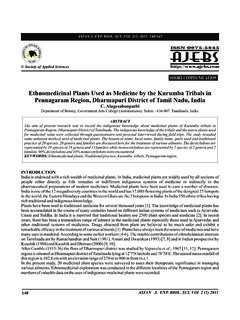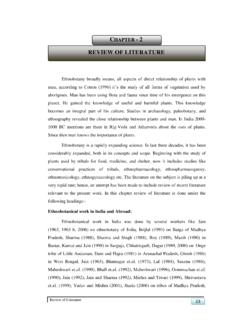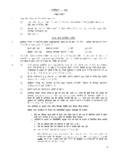Transcription of Andhra Pradesh - Banajata
1 Andhra Pradesh Policies of NTFPs Acts & Rules. Notifications. Availability of NTFP. The state has two contiguous patches of forests - one that extends from the northeast to northwest and the other starting from central AP towards the south. It is in these two regions that the NTFP are found. Even within these two regions - it is the northern region that accounts for most of the availability of NTFP in terms of quantity and value. Beedi leaf and bamboo are the two NTFP that are important for the quantum of availability and returns to both individuals and the state. Though these two produces are available in most part of the forests, its concentration is in the north both in terms of quantity and quality.
2 There are many other NTFP. available in the state that are crucial for the livelihoods of people collecting them though there value is not as high as bamboo or beedi leaf. The important among them are - Tamarind mostly found in the north part, gums all over the state's forests, Adda leaf, Myrobolans, Honey, and various other fruits, barks and roots. Most of them have local presence - are not found through out the state. Many of the NTFP found in the state are mentioned in the following table. The state is rich in medicinal plants. Over 350 species of medicinal plants are reportedly available in the state.
3 A study done by Padmavathi Devi of Andhra University in 4 villages of North-eastern AP forests identified a total of 256 species, out of which 63% are important from the point of view of NTFP. The detailed use categories of the species is as follows - Medicinal (48%), Commercial (8%), Food (8%), Fodder (11%), Religious (2%), Ornamental (4%) and other (16%). Table: NTFP in AP. Product Name Scientific Name Seasonality End Use Category Beedi Leaf Diospyros Leaf Mar - May Indian Cigar Melanoxylon Adda Leaf Bauhinia Vahili Leaf Nov - May Plates Saraswathi Centella Asiatica Leaf Karivepaku Murraya Koenigi Leaf Jun - Jan Withania Aswagandha Leaf Somnifera Andrographis Nelavemi Leaf paniculata Limonia Leaf and Velaga Medicine acidissima Bark Naramamidi Litsea Glutinosa Bark Mar - May Incense sticks Polyathiha Bark &.
4 Guthipandu cerasoides Fruit Edible Use for Chinta Kaya Tamarindus Fruit Feb - Apr sourness, Seed in (Tamarind) Indica Pharmacy etc. Kunkudu Sopandis indica Fruit Eethapandu Fruit Tani, Tadakayulu, Terminalia Fruit Apr - Jun Thati Chettu Bellerica Terminalia Tanning and Karaka Fruit Dec - Feb Chebula Medicinal Emblica Usiri, Neeli (Aonla) Fruit Jan - Feb Officinalis Azadirachta Vepaginjalu Fruit May - Jun Medicinal Indica Strychnos Nux Musti Ginjalu Fruit Nov - Jan Medicinal Vomica Fruit and Billa Ganneru Lochnera Rosea Seed Uttiginjalu Seed Jan Morli, Sarapappu Buchanania Seed Apr - May Sweets, Facial (Chironji) lazan powder and Ice creams Sapindus Kunkudu (Soapnut)
5 Seed Mar - Apr Emerginatus Nallajeedi (Marking Semecarpus Seed Feb- Mar Nuts) Anacardium Chilla (Cleaning Strychnos Seed Oct- Jan Nut) Potatorum Pongamia Kanuga Seed Apr - May Pinnata Seed and F - May - Jun, Flower - Edible, Seed Vippa (Mahua) Madhuca Lotifolia Flower S - Jun - Jul - Oil Tapsi, Errapoliki, Stem Yerra Polika (Gum Sterculia Urens Oct - Jun Extract Karaya). Kondagogu, Cochlospermum Stem Oct - Jun Erragogu Religiosum Extract Stem Anduga, Guggilam Boswellia Serrata Oct - May Extract Buraga Banka Stem Bombax ceiba Gums in Edible, Non - chettu Extract edible uses, Stem Elamabanka pharmaceutical, Extract Paints and Varnishes, Anogeissus Stem Gum Tiruman Apr - May Latifolia Extract Stem Gum Ollibanum Extract Lanea Gum Gumpena Oct - Jun Coramandalica Stem Gum Dikamali Extract Rock Bee Honey Oct - Nov, Edible and Medicinal Apr - May Apiary Honey Apis indica Grass, Grass - thatch roofing, Gymnema Bodha.
6 Podapathri Stem/ Dec - Feb Stem / leaf - medicinal Sylvestre Leaf properties Porakalu Grass Brooms Thysanolaena Hill Brooms Grass Nov- Mar Brooms Maxima Green Grass Grass Herbal Rauvolfia Sarpagandhi Root Serpentia Chenchu Gadalu Root Maredu, Maredukayalu, Aegle Marmelos Root Apr - May Maredigadda Kalabanda Aloe Barbadnesis Root Sugandhalu, Hemidesmus Sugandhipala, Root Mar - May Indicus Budipala Gaddalu Medicinal, local soft Nannarigaddalu Root Feb- Mar drink Palagadda Root Palasepugadda Root Decalepis Madanagaddalu Root Mar - May Hamiltoni Gymnema Root and Podaparthi Sylvestre Leaf Shekakai Boosipikkalu Nov - Dec Kakkuthikayalu Jan - Feb Seethaphal Sep -Nov Ramaphal Jan - Feb Kagupikkalu Feb- Mar Paalateega Sep - Oct Source:RCDC Doc.
7 Cell Policies influencing NTFP management and trade The significance of NTFP to the state was perhaps realised first when the report of the Industrial Survey Committee appointed by the erstwhile government of central provinces and Berar was published in 1939. The report emphasised NTFP as a source of forest revenue as well as for creation of employment in the rural areas. As a consequence of this realisation trade in some NTFP was nationalised. The initial focus given to the idea of integrating tribal development through NTFP was further emphasised by the recommendations of the Scheduled Areas and Scheduled Tribe Commission (1960-61), commonly known as Dhebar Commission.
8 Some of the findings (in the 50s) are quite interesting and holds true even now after almost half a century. With the rich resource base that the forest areas possess, there is no reason why there should be unemployment in these areas. The forest department in consultation with agricultural industries and development departments in each region should prepare a time schedule with the intention of providing work all the year round. This should include among others collection of forest produce, exploitation of minor forest produce and exploitation and processing of major forest produce Government should accept as a policy that, as far as possible it would take steps to eliminate the middlemen between the inhabitants of the forests and the forest department in relation to exploitation of the forests.
9 The system of monopoly operating at the moment must in any case be ended. Very little attention has been paid to the processing side of the minor forest produce and the produce is being sold in raw form. Processing of NTFP can be a great source of employment for the tribal people. It involves training, of course, and the supply of tools and instruments. This can be organised on a co-operative basis. It would also be useful to see what the report of Study team on Tribal Development Programmes constituted by the Planning Commission and submitted to the Prime Minister in 1969 had to say " The regulation of tribal rights should not be carried beyond the requirements of prudent forest management, and become an irksome restriction as, for example, in the case of denial to the tribals' freedom, which they have enjoyed for hundred of years in relation to collection of NTFP, which does not harm the forest in any way.
10 By the induction of contractors to this business, the FD has deprived the tribals of subsidiary incomes and thereby dealt a severe blow to their economy. The fear that restoration of the privileges will lead to a loss of revenue is no argument for extinguishing without payment of compensation, a traditional right, the exercise of which does not in any way detract the value of " It went on to say that if there are losses to be borne by the state by foregoing the restriction, let it be so. Further it states that the only exception could be as has been done in the case of AP, where a tribal co-operative agency sponsored by the government is awarded monopoly rights and can be depended upon to provide a remunerative price to the tribals.






